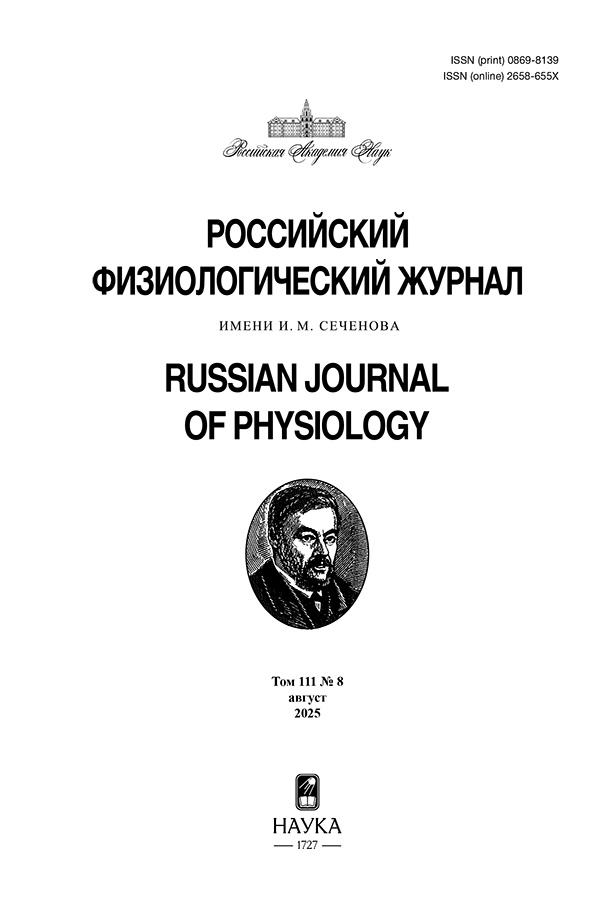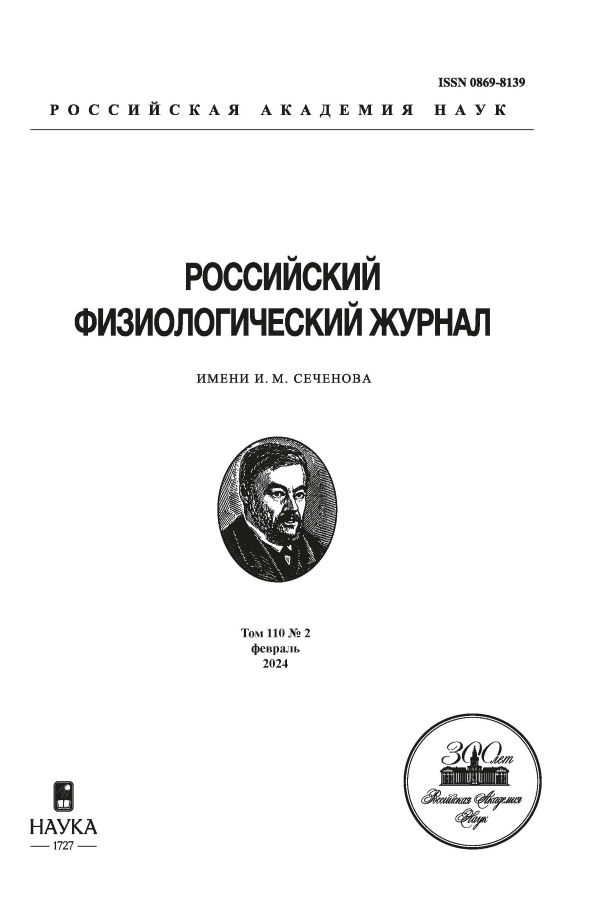Временная шкала адаптации при обработке звуковых последовательностей нейронами первичной слуховой коры бодрствующих мышей (mus musculus)
- Авторы: Егорова М.А.1, Акимов А.Г.1, Хорунжий Г.Д.1
-
Учреждения:
- Институт эволюционной физиологии и биохимии им. И.М. Сеченова РАН
- Выпуск: Том 110, № 2 (2024)
- Страницы: 157-168
- Раздел: ЭКСПЕРИМЕНТАЛЬНЫЕ СТАТЬИ
- URL: https://hum-ecol.ru/0869-8139/article/view/651669
- DOI: https://doi.org/10.31857/S0869813924020016
- EDN: https://elibrary.ru/DKEXFV
- ID: 651669
Цитировать
Полный текст
Аннотация
Впервые исследовали постстимульную слуховую адаптацию нейронов первичных полей слуховой коры у бодрствующих домовых мышей к звуковым последовательностям, образованным четырьмя 100-миллисекундными тональными сигналами, частота которых соответствовала характеристической частоте нейрона, интервал между тональными составляющими одной последовательности был одинаков, а в разных последовательностях варьировал от 0 до 2000 мс. Анализ полученных результатов продемонстрировал эффект адаптации в ответах подавляющего большинства исследованных нейронов, выражавшийся в отсутствие активности или значительном снижении активности, вызванной следующими за первым компонентами серии звуков, при межстимульных интервалах 0–500 мс. Количественная оценка проявления адаптации в зависимости от величины межстимульных интервалов в последовательности тонов по всей популяции исследуемых нейронов выявила сходство временных шкал адаптации бодрствующих и наркотизированных мышей.
Полный текст
Об авторах
М. А. Егорова
Институт эволюционной физиологии и биохимии им. И.М. Сеченова РАН
Автор, ответственный за переписку.
Email: ema6913@yandex.ru
Россия, Санкт-Петербург
А. Г. Акимов
Институт эволюционной физиологии и биохимии им. И.М. Сеченова РАН
Email: ema6913@yandex.ru
Россия, Санкт-Петербург
Г. Д. Хорунжий
Институт эволюционной физиологии и биохимии им. И.М. Сеченова РАН
Email: ema6913@yandex.ru
Россия, Санкт-Петербург
Список литературы
- Adrian ED (1928) The basis of sensation. New York. W.W. Norton.
- Бибиков НГ (2010) Нейрофизиологические механизмы слуховой адаптации. II. Эффекты последействия. Успехи физиол. наук 41(4): 77–92. [Bibikov NG (2010) Neurophysiological mechanisms of auditory adaptation. II. Aftereffects. Advanc Physiol Sci 41(4): 77–92. (In Russ)].
- Ulanovsky N, Las L, Farkas D, Nelken I (2004) Multiple time scales of adaptation in auditory cortex neurons. J Neurosci 24(46): 10440–10453. https://doi.org/10.1523/JNEUROSCI.1905-04.2004
- Malmierca MS, Sanchez-Vives MV, Escera C, Bendixen A (2014) Neuronal adaptation, novelty detection and regularity encoding in audition. Front Syst Neurosci 8: 111. https://doi.org/10.3389/fnsys.2014.00111
- Valdés-Baizabal C, Carbajal GV, Pérez-González D, Malmierca MS (2020) Dopamine modulates subcortical responses to surprising sounds. PLoS Biol 18(10): e3000744. https://doi.org/10.1371/journal.pbio.3000984
- Bregman AS (1990) Auditory scene analysis. The Perceptual Organization of Sound. Cambridge. MA. MIT Press.
- MacDougall-Shackleton SA, Hulse SH, Gentner TQ, White W (1998) Auditory scene analysis by European starlings (Sturnus vulgaris): Perceptual segregation of tone sequences. J Acoust Soc Am 103(6): 3581–3587. https://doi.org/10.1121/1.423063
- Kanwal JS, Medvedev AV, Micheyl C (2003) Neurodynamics for auditory stream segregation: tracking sounds in the mustached bat’s natural environment. Network 14(3): 413–435. https://doi.org/10.1088/0954-898X_14_3_303
- Gaub S, Ehret G (2005) Grouping in auditory temporal perception and vocal production is mutually adapted: the case of wriggling calls of mice. J Comp Physiol A 191: 1131–1135. https://doi.org/10.1007/s00359-005-0036-y
- Pérez-González D, Malmierca MS, Covey E (2005) Novelty detector neurons in the mammalian auditory midbrain. Europ J Neurosci 22(11): 2879–2885. https://doi.org/10.1111/j.1460-9568.2005.04472.x
- Pérez-González D, Hernández O, Covey E, Malmierca MS (2012) GABAA-mediated inhibition modulates stimulus-specific adaptation in the inferior colliculus. PLoS One 7(3): e34297. https://doi.org/10.1371/journal.pone.0034297
- Anderson LA, Malmierca MS (2012) The effect of auditory cortex deactivation on stimulus-specific adaptation in the inferior colliculus of the rat. Eur J Neurosci 37(1): 52–62. https://doi.org/10.1111/ejn.12018
- Malmierca MS, Cristaudo S, Pérez-González D, Covey E (2009) Stimulus-specific adaptation in the inferior colliculus of the anesthetized rat. J Neurosci 29(17): 5483–5493. https://doi.org/10.1523/JNEUROSCI.4153-08.2009
- Valdés-Baizabal C, Casado-Román L, Bartlett EL, Malmierca MS (2021) In vivo whole-cell recordings of stimulus-specific adaptation in the inferior colliculus. Hear Res 399: 107978. https://doi.org/10.1016/j.heares.2020.107978
- Anderson LA, Christianson GB, Linden JF (2009) Stimulus-specific adaptation occurs in the auditory thalamus. J Neurosci 29(22): 7359–7363. https://doi.org/10.1523/JNEUROSCI.0793-09.2009
- Antunes FM, Malmierca MS (2011) Effect of auditory cortex deactivation on stimulus-specific adaptation in the medial geniculate body. J Neurosci 31(47): 17306–17316. https://doi.org/10.1523/JNEUROSCI.1915-11.2011
- Malinina ES, Egorova MA, Khorunzhii GD, Akimov AG (2016) The time scale of adaptation in tonal sequence processing by the mouse auditory midbrain neurons. Dokl Biol Sci 470: 209–213. https://doi.org/10.1134/S001249661605001X
- Egorova MA, Malinina ES, Akimov AG, Khorunzhii GD (2018) Adaptation of different types of neurons in the midbrain auditory center to sound pulse sequences. J Evol Biochem Physiol 54(6): 482–486. https://doi.org/10.1134/S002209301806008X
- Egorova MA, Akimov AG (2020) Specialization of neurons with different response patterns in the mouse Mus musculus auditory midbrain and primary auditory cortex during communication call processing. J Evol Biochem Physiol 56: 406–414. https://doi.org/10.1134/S0022093020050038
- Egorova MA, Khorunzhii GD, Akimov AG (2019) The timescale of adaptation in tonal sequence processing by mouse primary auditory cortical neurons. J Evol Biochem Physiol 55: 497–501. https://doi.org/10.1134/S0022093019060085
- Joachimsthaler B, Uhlmann M, Miller F, Ehret G, Kurt S (2014) Quantitative analysis of neuronal response properties in primary and higher-order auditory cortical fields of awake house mice (Mus musculus). Eur J Neurosci 39(6): 904–918. https://doi.org/10.1111/ejn.12478
- Joachimsthaler B, Brugger D, Skodras A, Schwarz C (2015) Spine loss in primary somatosensory cortex during trace eyeblink conditioning. J Neurosci 35(9): 3772–3781. https://doi.org/10.1523/JNEUROSCI.2043-14.2015
- Egorova MA (2005) Frequency selectivity of neurons of the primary auditory field (A1) and anterior auditory field (AAF) in the auditory cortex of the house mouse (Mus musculus). J Evol Biochem Physiol 41: 476–480. https://doi.org/10.1007/s10893-005-0085-4
- Ehret G, Riecke S (2002) Mice and humans perceive multiharmonic communication sounds in the same way. Proc Natnl Acad Sci U S A 99(1): 479–482. https://doi.org/10.1073/pnas.012361999
- Stiebler I, Neulist R, Fichtel I, Ehret G (1997) The auditory cortex of the house mouse: left-right differences, tonotopic organization and quantitative analysis of frequency representation. J Comp Physiol A 181: 559–571. https://doi.org/10.1007/s003590050140
- Duque D, Malmierca MS (2015) Stimulus-specific adaptation in the inferior colliculus of the mouse: anesthesia and spontaneous activity effects. Brain Struct Funct 220: 3385–3398. https://doi.org/10.1007/s00429-014-0862-1
- Nieto-Diego J, Malmierca MS (2016) Topographic distribution of stimulus-specific adaptation across auditory cortical fields in the anesthetized rat. PLoS Biol 14(3): e1002397. https://doi.org/10.1371/journal.pbio.1002397
- Von der Behrens W, Bäuerle P, Kössl M, Gaese BH (2009) Correlating stimulus-specific adaptation of cortical neurons and local field potentials in the awake rat. J Neurosci 29(44): 13837–13849. https://doi.org/10.1523/JNEUROSCI.3475-09.2009
- Farley BJ, Quirk MC, Doherty JJ, Christian EP (2010) Stimulus-specific adaptation in auditory cortex is an NMDA-independent process distinct from the sensory novelty encoded by the mismatch negativity. J Neurosci 30(49): 16475–16484. https://doi.org/10.1523/JNEUROSCI.2793-10.2010
- Вартанян ИА (1978) Слуховой анализ сложных звуков. Л. Наука. [Vartanyan IA (1978) Auditory analysis of complex sounds. L. Nauka. (In Russ)].
- Бобошко МЮ (2012) Речевая аудиометрия: учебное пособие. СПб: Изд-во СПбГМУ. [Boboshko MJ (2012) Speech audiometry: textbook. St. Petersburg: Publ House of St. Petersburg State Med Univer. (In Russ)].
Дополнительные файлы














